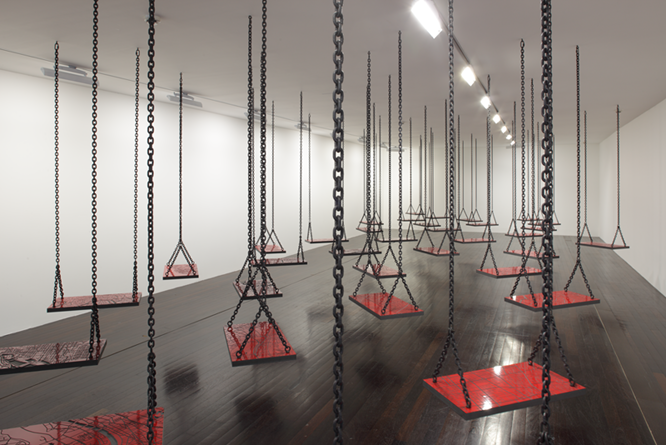From the Work to the Artist
Mona Hatoum was born in 1952 in Beirut, Lebanon and today lives and works in London and Berlin.
Mona Hatoum, of Palestine origin and born in Beirut, left Lebanon for what ended up as being a one-way trip, as civil war broke out during her absence. She went into exile in 1975, doing her studies and finally settling down in London. She then extended her working area to another capital, Berlin. These constant return trips between two cities are just part of her travels abroad for international exhibitions. In her first works in the 1980’s, she often showed the body, a woman’s body in situations of deadlock, imprisonment and resistance. Under Siege: a highly disturbing experience where Mona Hatoum spends seven hours in a transparent cube filled with watery mud. Envisaging this relation between the inside and outside, the artist provokes surprise in 1994 in Paris with her video installation of Corps étranger shown at the Centre Pompidou. She invited visitors to explore her own body, made naked by an endoscopic camera, admiring her incredible geographical interior with forests, volcanoes, seas, deserts all the reliefs of this “foreign” land intimate and unknown, individual and universal.
Literally and figuratively, using various practical and referenced mediums (minimalist, Arte Povera), Mona Hatoum works and shares her rambling to the limits of anguish. The spectator physically endures these interwoven, seemingly familiar worlds which she presents disassembled from their context, enlarged or shrunk and whose usage is unsettling. Commonplace objects are often the subject of her installations (Sous tension, 1999, Homebound, 2000). The harsh geometry of fencing and cages in Light Sentence (1992) act the same as the elasticity of digestive tube walls in Corps étranger.
If the mere fact of depicting violence towards women qualifies a person as “feminist” then yes, Mona Hatoum is undoubtedly a feminist. The video Measures of distances (1998) shows another body in the shower – that of her mother. This body is linked to a story, an exchange of letters between mother and daughter – this correspondence resurfaces on the screen, obscuring slightly the video image.
Sexuality, exile, uprooting, violence and intimacy – this video summarizes numerous concerns of the artist as well as those of an entire generation. The work of Mona Hatoum is often qualified as that of promoter in contemporary art.
Distance geography
Her constant search for new places led her to the MAC/VAL in 2009, within the framework of a residence – a creation undertaken in accordance with the given information and coordinates of an area. She took this opportunity to undertake her favourite motif – the map. Continental Drive (2000): Mona Hatoum organized a spin-off of continents using mirrors and following a clock’s mechanism. Moth-eaten pieces on a rug (Afghan, red and black, 2008), which in fact are the geographical outlines of continents (Routes V, 2008), clear glass marbles spread over the floor, representing continents – but suggestive of political instability from the possibility of these glass balls easily moving, warning the visitor not to slip (Map, 1998)… her obsession with maps brought on all sorts of potential forms.
At the MAC/VAL, with the installation Suspendu, the map becomes a position game awaiting movement and forming a giant forest of forty swings. Each seat is engraved with the map of a city or capital linked to the people met in the various communities of Vitry-sur-Seine. Clean-cut from the wood, these geometrical maps with broken or interrupted lines personify lived lives, relationships with history and family and individual experiences. Instability and balance, temporal distance between childhood and adulthood resonate with the heavy chains which seemingly nail each swing in the air. They are in total contrast with the two swings in A couple of swings,1993, where the glass seats combine ethereal and frailty along with added frustrations conjoined to the impossibility of playing and using the object for fear it may break.
A network of assigned places, a worrisome play area – this planisphere where you can wander around, changing positions. Plate tectonics are conceivable, moving the vertical chains to horizontal planks - their possible confrontation, lateral jostling and swaying. Mona Hatoum’s installations give you free rein for developments, change of plans, views, all beyond an initial immediacy.
